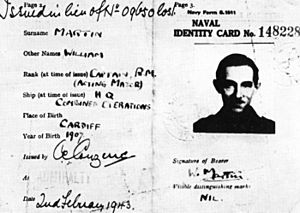Ronnie Reed facts for kids
Ronald Thomas Reed (born October 8, 1916 – died January 22, 1995) was a clever engineer who worked for the BBC radio. During World War II, he joined MI5, which is Britain's security service. His job was to manage secret agents who pretended to work for the enemy but were actually helping Britain. These were called double agents.
Contents
Early Life and Interests
Ronnie Reed was born in St Pancras, London. His father passed away when Ronnie was very young, during the First World War. Ronnie grew up with his mother and was a choirboy at a local church.
From a young age, Ronnie was fascinated by radio. He even built his own simple radio system! He was very good at school and earned a scholarship to the Regent Street Polytechnic. There, he studied to become an electronic engineer. He even built an early version of a TV, called a Baird Televisor. In 1938, he started working for the BBC, helping with many live radio broadcasts from different places.
Joining the Secret Service
In 1940, the BBC asked Ronnie to go on a special assignment. This led him to HM Prison Wormwood Scrubs, which was where MI5 had its main office at the start of World War II. He was taken to a cell where a German spy, named Agent Summer, was being held. Ronnie's job was to help make sure this spy's first radio message back to Germany sounded real. The spy was telling Germany he had landed safely in Britain.
After this, Ronnie continued to work with other double agents. These included agents known as Agent Snow, Agent Celery, and Agent Tate. He became a permanent officer for MI5, helping to stop enemy spies and secret plans. One of the most important agents he managed was Agent Zigzag, whose real name was Eddie Chapman. Ronnie worked with him from 1942 to 1944.
The Man Who Never Was
Ronnie Reed was also involved in a very clever trick during the war, called "The Man Who Never Was". In 1943, British officers needed to create a fake identity for a dead body. This body would be used to trick the enemy with false invasion plans. They needed a photo for the fake ID card, but couldn't find anyone who looked like the body.
Then, one day, Commander Ewen Montagu, who came up with the plan, saw Ronnie Reed. He realized Ronnie looked exactly like the dead body! So, Ronnie Reed's photograph was used for the fake identity card. This helped make the trick believable.
Life After the War
During World War II, Ronnie met Mary Dyer. They got married in June 1946 and had two sons. By the early 1950s, Ronnie was a very important officer in MI5. He was in charge of the section that dealt with Russian spies. This meant he was involved in investigating famous spies like Klaus Fuchs, Kim Philby, Guy Burgess, and Donald Maclean.
In 1957, Ronnie Reed and his family moved to New Zealand for three years. Officially, he was working for the Foreign Office, but his real job was to help New Zealand set up its own intelligence agency, similar to MI5. This meant New Zealand could handle its own spy investigations instead of them being managed from Britain.
Ronnie and his family returned to the UK in 1960. He retired from MI5 in 1976 when he was 60 years old. He passed away in 1995 in Dulwich, South London. Ronnie also wrote a special report about radio work during World War II, which was included in the official history of British Intelligence during the war.



